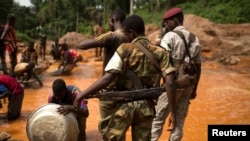From the edge of the crater, an armed man barks his orders in broken Sango. Fifty meters down, at the bottom of the giant man-made pit, the miners look up at their new boss.
As foreign gold and diamond mine operators fled the conflict in the Central African Republic, anti-balaka militia and Seleka rebels gradually replaced them. In the village of Ndassima, in the eastern C.A.R., the Seleka rebels have taken control of the mine and its revenues.
“Now it’s the rebels who buy our gold. They also control the mine and the workers,” said Frederique Ningando, a miner.
When the Seleka rebels took his hometown of Bria in December 2012, Ningando left the mining town in the northeastern C.A.R. to look for work. He arrived in Ndassima only to discover the rebels had made it there before he did.
When the national army fled, the Seleka positioned themselves as protectors of miners and collectors, demanding monthly protection payments from agencies and mineworkers.
"The foreign diamond collectors don’t dare to come here anymore,” said Ibrahim Kodegeue, a trader who buys gold from miners nearby.
The miners in Ndassima transport and sell their gold in Bambari, the nearest major town. There, they deal with traders from Chad and Sudan, who have replaced the buyers who used to come from Bangui.
Cooperation with rebels
The road to Bambari is controlled by the rebels, who often act as middlemen.
“We cooperate with the Seleka while we’re waiting for the government to come back," said Kodegeue. "As there’s no security on the road and people from the mine travel with a lot of money. We depend on the rebels.”
The smuggling of gems and gold is one of the biggest challenges facing the C.A.R.'s fragile transitional government.
Smugglers move their wares out of the country. The levy the C.A.R. applies on the value of diamond exports is 12 percent, compared with 3.2 percent in the Democratic Republic of Congo and 5 percent in Congo-Brazzaville. For gold, the rate in Cameroon is also lower than in the C.A.R.
C.A.R. mining companies now fear Cameroon’s recent membership in the Kimberley Process will increase the smuggling.
The Kimberley Process, an international agreement to prevent trade in conflict diamonds, stopped all legal trade with diamonds from the C.A.R. more than 18 months ago.
Trade continues
While the miners in Ndassima say they feel the effect of the international trade ban, they add that trade continues almost as it did before.
“Gold is always easier to sell. The control on diamonds is much stricter," Kodegeue said. "Here, however, everything is done by hand. We don’t have any machines to dig and extract the gold. It’s hard work for very little money. We wait for the mining companies to return.”
That is not likely to happen soon. Despite the presence of French troops and U.N. peacekeepers, fighting between ex-Seleka and anti-balaka forces, as well as clashes between armed cattle herders, threatens security in areas that until recently were considered relatively safe.
Security in the mine has deteriorated since the government left. During the rains in September, a part of the mine collapsed, killing at least 27 miners. Several others are believed to have been buried under the slippery mud.
For two weeks, all work in the mine stopped. But the miners are back at work, fearful the walls around them will collapse, and worried about the men who now control their livelihoods.








